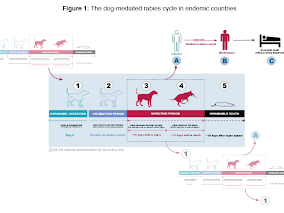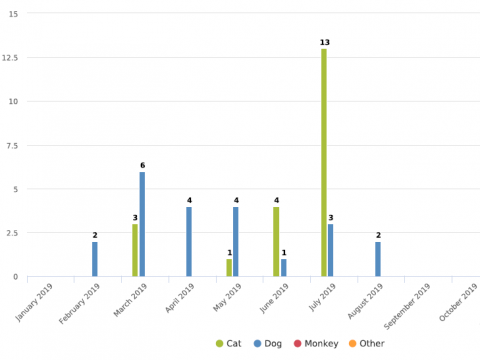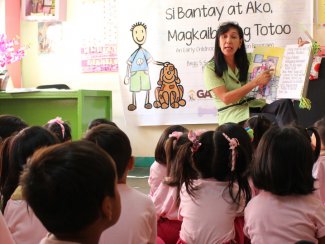Community surveillance and education boost rabies control at the village level
To facilitate real-time data collection and to notify authorities of suspect rabies cases for timely intervention, GARC’s Community-Based Rabies Surveillance (CBRS) project was implemented in the Philippines in February 2019 (see article here). The CBRS uses enhanced communications and technology to boost surveillance at the local level, allowing for incidents early in the rabies cycle to be closely tracked and alerting communities to the presence of rabies sooner.
The CBRS project was implemented by GARC in the barangay (village) of Poblacion in Muntinlupa City, a highly urbanized area, in an effort to stem the rising tide of rabies in the area. During the implementation of the CBRS system over the past 6 months, reportable rabies events increased in 2019 compared to the previous year. Additionally, as of August 2019, a total of 8 confirmed animal rabies cases were detected in the entire city, compared to just 5 in 2018 (see graph).
With the CBRS project showing some success at detecting more rabies-related incidents, the next phase of the project includes rolling out the CBRS system to another seven barangays in Muntinlupa City by the last quarter of 2019, as well as adding another three government bite centers, where community members can receive post-exposure prophylaxis (PEP).
The CBRS early warning and rapid response system was established with the primary goal of enhancing field surveillance of rabies. By providing more immediate detection of suspected rabies cases, the CBRS expands how high risk dog bites are reported and investigated with the aim of decreasing the transmission of virus among animals and humans.
Active surveillance allows for the detection of rabies in the community during a period when rabies can be the most infective, with the intent of disrupting the dog-mediated rabies cycle (see figure). Instead of waiting for a suspected human rabies death to take action, the CBRS project encourages the reporting of all events that may lead to a rabies infection, such as dog bites or reports of strangely behaving animals. In addition, to ensure community vigilance, the CBRS also has a negative reporting component that helps demonstrate the lack of suspect rabies cases in an area despite active surveillance.
The CBRS project relies upon the One Health approach, wherein village health workers, medical personnel (bite center doctors and nurses), veterinary staff, epidemiologists and laboratory diagnosticians share crucial data at the soonest time in order to trigger a rapid response in the field. One way that information is shared quickly using the CBRS system is via immediate SMS and email notifications to the relevant authorities. Below is an example of the SMS and email messages that were generated using the Rabies Epidemiological Bulletin - the platform on which the CBRS is built. The surveillance system has the capacity to link the biting animal with a bite victim and trace the same animal when a sample is submitted to the laboratory.
|
|||||||||||
|---|---|---|---|---|---|---|---|---|---|---|---|
An additional component of the project is implementing a community education campaign designed to reach diverse audiences, including day care students, parents and teachers. A large percentage (20%) of bite victims in Muntinlupa City in 2018 were young children children (< 5 years old); so in collaboration with the Early Childhood Education Division of the Social Services Department of the city, rabies educational modules will be developed for day care students (children ages 3-5) and their parents, with the key messages focusing on animal bite prevention, management, reporting and responsible pet ownership.
Another community education initiative being explored is the development of rabies education modules for the household recipients of the Conditional Cash Transfer (CCT) Program of the government. As part of the social welfare program of the national government, one of the requirements to be able to receive the monthly cash allowance is to attend these Daily Development Sessions. Urban public school teachers will also be trained as rabies educators to support the national integration of rabies education in all public schools in the Philippines (see recent article here).
CBRS project is a collaboration between the City Government of Muntinlupa, Research Institute of Tropical Medicine-Department of Health and GARC with funding support from Fondation Botnar and Fundacion Probitas.
Submitted by Dr Sarah Jayme, GARC Asia Representative


